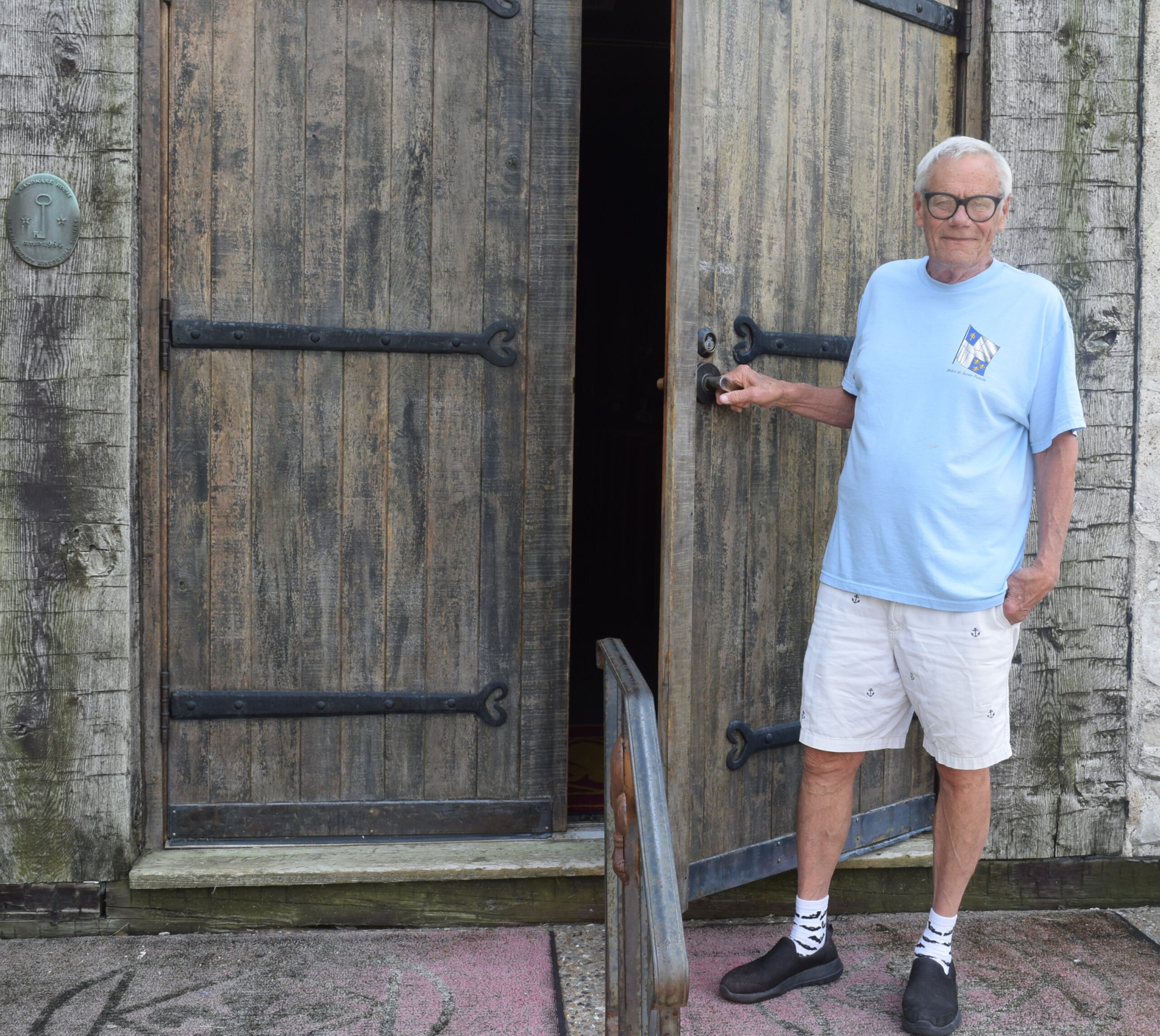John Reed (above) is an expert on the 325-year history of Holy Family Catholic Church in Cahokia Heights, and has given many tours to people interested in stories of the old Log Church (David Wilhelm photo).
Ten generations of John Reed’s family have been parishioners at Holy Family Catholic Church in Cahokia Heights, a parish that is the oldest continuous Catholic parish in the United States.
Reed’s ancestors, originally from France, arrived in Cahokia in 1740 from Quebec, Canada.
That’s 10 generations of a family who has had baptisms, weddings and funerals at Holy Family Church, along with experiencing all the other sacraments and celebrations within a parish community.
This also included Reed and his wife, Denita, who were married 51 years ago in the old Log Church.
Founded in 1699, Holy Family recently celebrated its 325th anniversary with tours, Mass celebrated by Bishop Michael McGovern and a dinner. Reed estimates more than 400 people attended.
“The six living priests who had served at the parish, going back 30 to 35 years, joined the celebration,” Reed said.
Since his retirement 20 years ago, Reed has been a tour guide and historian at Holy Family.
Reed, 75, spoke with much passion when he talked about the rich history of this parish that was so important to him and his ancestors and the Village of Cahokia, now called Cahokia Heights.
Looking back
Missionaries from Quebec arrived in Cahokia on Dec. 8, 1698, for the Feast of the Immaculate Conception, and offered the first Mass on the banks of the Mississippi River. They continued traveling south on the Mississippi, to what is now Arkansas.
When they failed to find a better spot than Cahokia, they returned to the area along Rigolet Creek in January 1699. Their purpose was to convert the local Tamaroa Indians.
“The priests from Canada traveled in canoes down the Mississippi River to reach this area,” Reed said. “Everything they had, including the items they needed for Mass, had to be lightweight and easy to transport in their canoes. The chalice they brought is designed to be folded when not being used.”
Reed said they chose the location of the church because it was a high point in the area.
“There has only been one time the flood waters reached the doors of the church — in 1892 or 1893,” Reed said. “But the church has never flooded.”
The first Log Church was dedicated on May 14, 1699. Father St. Cosme and two French workmen erected a cross, log chapel and log rectory to establish the new parish that they named “Sainte Famille,” French for Holy Family.
The original structure burned about 1740. The cabin standing today was built from the logs salvaged from the original church. It was dedicated on Sept. 24, 1799.
This Log Church is the only one of five built in a French Colonial style that still exists in North America. The timbers are all black walnut, 90% of which are original. A wood expert estimates that these timbers are from trees that were growing in the area when Columbus landed in the New World in 1492. This church and the Cahokia courthouse, also of similar construction, are the only two buildings remaining from Cahokia to Oregon that Meriwether Lewis and William Clark would have seen during the Lewis and Clark Expedition that began in 1804.
The visit by Lewis and Clark is one of three notable events in the church’s history that Reed considered special.
“Inside the old Log Church,” Reed said, “they spent time with Nicholas Jarrot, a wealthy parishioner, planning their trip to Oregon.”
Another story happened during the Revolutionary War. Fr. Pierre Gibault arrived from Canada in 1768 to serve the people of Cahokia and the surrounding area. Like his parishioners, the “patriot priest” was opposed to England’s rule and supported the American Revolution.
When Gen, George Rogers Clark entered Cahokia on July 6, 1778, the people gladly switched their allegiance from England to the American colonists and many joined the Revolutionary Army.
“General Clark also met with about 1,000 Native Americans from many different tribes to convince them to fight for the American side or to at least not fight for the British,” Reed said.
Reed also told the story of Jean Baptiste Du Sable, a former enslaved person from northern Illinois who wanted to marry a Native American woman. The missionaries told him no. The couple came to Holy Family Church to marry and returned home. Du Sable built one of the first homes in the area now known as Chicago.
“A huge statue of Du Sable is located in Chicago,” he said.
Other notable visitors to the area and the church were Abraham Lincoln and Charles Lindbergh.
The museum
In 2016, Holy Family Museum was opened in the former school.
The museum displays some of the parish’s most cherished artifacts, including the chalice and paten used in Holy Family’s first Mass in 1698. This chalice was also used by Saint John Paul II when he celebrated Mass on his visit to St. Louis in 1999.
Also on display are New and Old Testaments printed in France in 1568; a Latin missal printed in 1668 in Antwerp, Belgium; a monstrance made in France in 1717; and several candlesticks that were a gift from King Louis XIV of France.
Bill Graves, a church trustee, also provides tours of the Log Church and the museum.
For Reed, the story of Holy Family Catholic Church, located within the Diocese of Belleville, is meant to be shared and is meaningful to anyone who loves history.
“I love showing off this church,” Reed said.
For tours of the Log Church and the museum, contact the Holy Family rectory at 618-337-45478 or email [email protected].
Latin Mass is celebrated at the Log Church at 9 a.m. on Sundays. Mass is also celebrated in the new church building. For more information, visit www.holyfamily1699.org.







